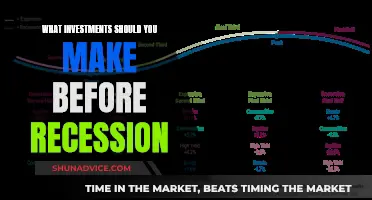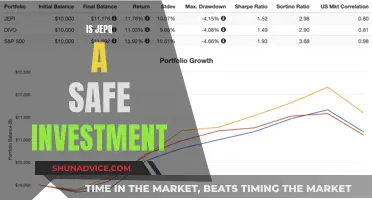
Saving and investing are two different approaches to achieving financial security. Saving is generally considered a low-risk option, as it involves setting aside money for future use, often in a savings account with minimal risk of losing value. On the other hand, investing involves using money to purchase assets, such as stocks or property, with the expectation of generating higher returns over time. While investing offers the potential for significant financial gains, it also comes with a higher risk of losing value. The decision to save or invest depends on various factors, including financial goals, risk tolerance, and time horizon.
| Characteristics | Values |
|---|---|
| Risk | Savings accounts have minimal risk. Savings account balances have no risk of declining and are insured by the FDIC. |
| Investing has a higher risk. You could lose money, break even, or earn a return—there are no guarantees. | |
| Returns | Yields on savings accounts usually only fluctuate if the federal reserve increases or decreases interest rates, which happen at set intervals throughout the year. |
| Investing offers fluctuating returns and the potential for high returns. | |
| Accessibility | Withdrawing and transferring money to and from a savings account is easy. |
| Investment accounts may charge penalties or taxes for withdrawing investment gains early. | |
| Timeframe | A savings account is good for short-term needs, such as an emergency fund or cash needed within the next three to five years. |
| Investing is good for long-term goals, such as retirement, and is ideal for goals that are at least three to five years away. |
What You'll Learn

Savings accounts vs investment accounts
Savings accounts and investment accounts are both important for building a sound financial foundation, but they serve different purposes. Here are some key differences between the two and when to choose one over the other:
Savings Accounts
Saving money is generally considered safer than investing, as it carries little to no risk of losing money. It is an excellent way to meet short-term financial goals and prepare for unexpected expenses. Money in savings accounts is also easily accessible and can be withdrawn at any time without penalties. Some of the pros of saving accounts include:
- Minimal risk of losing money
- Liquidity and easy access to funds
- Safety of funds (FDIC-insured accounts are protected up to $250,000 per depositor)
- No upfront cost or learning curve
However, there are also some drawbacks to saving accounts:
- Lower returns compared to investments
- Loss of purchasing power due to inflation
Investment Accounts
Investing, on the other hand, offers the potential for higher returns but comes with a higher risk of losing money. It is suitable for long-term financial goals, such as retirement or saving for college. Some benefits of investment accounts include:
- Potential for higher returns
- Ability to grow wealth over time
- Opportunity to achieve long-term financial goals
However, there are also cons to investing:
- Risk of losing money
- Volatility and potential for short-term losses
- Requires discipline and a long-term perspective
When to Choose Savings vs. Investment
The choice between saving and investing depends on your financial goals, time horizon, and risk tolerance. Here are some guidelines:
- If you need money in the next few years or have short-term goals, choose a savings account.
- If you don't have an emergency fund, prioritise saving first.
- If you are eligible for an employer match in your retirement account (e.g. 401(k)), consider investing to take advantage of the match.
- If you have long-term goals (5+ years) and can tolerate risk, investing may be a better option.
Betterment: Savings or Investment?
You may want to see also

Emergency funds
- Amount to Save: It's recommended to save three to six months' worth of living expenses. However, this may vary depending on your financial situation. For example, if you're single, three months' savings might suffice, while those with a spouse, kids, or a mortgage may prefer to aim for six months or more.
- Where to Keep Emergency Funds: It's best to keep emergency savings in a savings account that offers a high-interest rate and easy access. Separating it from your daily spending money can help prevent unnecessary spending.
- Account Options: Consider a high-yield savings account, money market accounts, or certificates of deposit (CDs). These options offer higher interest rates than traditional savings accounts, are federally insured, and provide quick access to your funds.
- Importance of Liquidity: Emergency funds should be easily accessible and liquid, allowing you to withdraw money quickly during emergencies. Avoid investing emergency funds in volatile assets like stocks, as you may be forced to sell at a loss when you urgently need the money.
- Avoiding Risky Investments: Avoid risky investments with your emergency funds. Opt for more liquid assets to ensure quick conversion to cash without penalties or loss in value.
- Building an Emergency Fund: Treat your emergency fund as a monthly bill and make regular contributions. You can also use tools like mobile apps to save automatically or adjust your tax withholdings to boost your savings.
Invest Your Savings: Safe Strategies for Beginners
You may want to see also

Short-term vs long-term goals
When deciding whether to save or invest your money, it's important to consider your short-term and long-term goals.
Short-term goals
Short-term investments are those that can be easily converted to cash, usually within five years of acquisition. Examples include CDs, money market accounts, high-yield savings accounts, government bonds, and treasury bills. These are typically high-quality and highly liquid assets.
Financial advisors recommend having an emergency fund as your first priority. This should cover three to six months' worth of living expenses. It's also wise to save for any upcoming expenses, such as a down payment on a house or an annual insurance premium.
Long-term goals
Long-term investments are assets that a company or individual plans to hold for more than a year. Examples include stocks, bonds, or derivative contracts. These investments are expected to increase in value over time, and the investor can sell them off in the open market to profit from the price appreciation.
Long-term investments are suitable for funding expensive future goals, such as retirement, or for building generational wealth. They can also produce a recurring income stream through investing in bonds, dividend-paying stocks, or real estate.
Short-term vs long-term
The main difference between short-term and long-term investments is the time horizon and the level of risk involved. Short-term investments are typically lower risk and provide more stable returns, while long-term investments carry a higher risk with the potential for higher returns.
Short-term investments are suitable for immediate or near-term financial goals, while long-term investments are better for goals that are at least three to five years away, as this allows time for the investment to recover from any losses.
It's important to find the right balance between short-term and long-term investments to meet your financial goals and manage your risk exposure. Diversification across various investment instruments can help spread out the risk.
Public Saving and Investment: Two Sides of the Same Coin?
You may want to see also

Risk and volatility
When it comes to investing, it's important to understand the concepts of risk and volatility, as they can significantly impact your investment decisions and outcomes.
Risk refers to the possibility of an asset losing value, while volatility is the likelihood of sudden or significant price swings. Volatility measures how frequently and how much the price of an asset fluctuates over time. It considers the speed and magnitude of price changes.
Measuring Volatility:
Volatility can be measured in two main ways:
- Historical Volatility: This looks at an asset's past price patterns over a specific period. While it provides valuable information, it may not accurately predict future volatility.
- Implied Volatility: This approach forecasts how much an investment's price will fluctuate during a future period. It is often calculated using options prices, which reflect investors' expectations of an asset's price movements.
The Relationship Between Risk and Volatility:
Managing Risk and Volatility:
To manage risk and volatility effectively, investors can employ the following strategies:
- Diversification: Diversifying your portfolio across different assets, sectors, and markets can help reduce risk. By investing in a range of securities with uncorrelated performance, you can lower the impact of market swings on your overall portfolio.
- Asset Allocation: Allocating your investments across different asset classes, such as stocks, bonds, commodities, and real estate, based on your risk tolerance, can balance risk and return.
- Long-Term Perspective: Taking a long-term view can help mitigate the impact of short-term volatility. Historical data shows that stock markets tend to rise over the long term, making short-term fluctuations less significant.
- Dollar-Cost Averaging: Investing a fixed amount consistently over time can smooth out the effects of volatility. By investing during both upswings and downswings, you can lower your average purchase price and potentially improve returns.
- Periodic Rebalancing: Regularly rebalancing your portfolio can help maintain your desired asset allocation. By adjusting your investments back to their target percentages, you can ensure that volatility doesn't throw your strategy off course.
- Patience and Information: Maintaining a long-term, patient outlook and staying informed about market developments can help you avoid impulsive decisions driven by short-term volatility. Understanding the underlying value of your investments can provide context for price fluctuations.
Maximizing Your Savings Account: A Guide to Smart Investing
You may want to see also

Returns
Potential for Higher Returns
Investing offers the potential for higher returns compared to simply keeping your money in a savings account. Over time, investing in a diversified portfolio that represents the entire market will likely result in greater returns than a high-yield savings account. This is especially true when considering returns above inflation. While savings accounts may provide a small amount of interest, the returns often fail to keep up with inflation, resulting in a loss of purchasing power over time.
Fluctuating Returns
One of the characteristics of investing is that returns can fluctuate. The financial markets are constantly changing, and the value of your investments will reflect these changes. This means that while you may experience high returns during favourable market conditions, there is also the possibility of negative returns or losses during market downturns.
Long-Term vs. Short-Term Returns
Investing is typically better suited for long-term goals, as it provides the opportunity for your money to grow over an extended period. For shorter-term goals, savings accounts are generally a more stable option, as they provide predictable returns and easier access to your funds.
Risk and Returns
It's important to understand the relationship between risk and returns. Investing carries a higher risk than saving, as you could lose money, break even, or earn a return. This risk is correlated with the potential for higher returns. In contrast, savings accounts offer minimal risk, as your balance will not decline, and your money is protected by FDIC insurance or similar schemes in other countries.
Compound Returns
One of the advantages of investing is the potential to benefit from compound returns. Compound returns occur when your investment earnings generate additional earnings over time. This can lead to exponential growth in your investment portfolio, especially when reinvesting dividends or interest income.
Tax Considerations
When considering returns on investments, it's important to factor in the impact of taxes. Depending on your jurisdiction, you may be subject to taxes on investment gains, dividends, or interest income. These taxes can reduce your overall returns, so it's crucial to understand the tax implications before investing.
In summary, investing offers the potential for higher returns, but it also comes with a higher level of risk and fluctuating returns. It is generally better suited for long-term goals, providing an opportunity to benefit from compound returns. However, taxes can impact your overall returns, so careful consideration and planning are necessary.
Monthly Savings: Invest Wisely, Grow Your Wealth
You may want to see also
Frequently asked questions
It depends on your financial goals and circumstances. Saving is generally for short-term goals, like an emergency fund or a down payment on a house, whereas investing is for long-term goals, like retirement. If you have more than one financial goal, you might consider doing both: saving for short-term goals and investing for long-term ones.
Saving is a low-risk option that allows you to preserve your money and have easy access to it. It's ideal if you need the money within the next three to five years. Additionally, saving is the first step to investing because you need to have savings to invest.
Investing has the potential to generate higher returns than saving, making it a good option for growing your money over the long term. It's also a way to build and preserve wealth for future generations.







